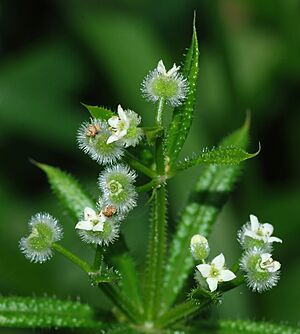Galium facts for kids
Quick facts for kids Galium |
|
|---|---|
 |
|
| Flowers of Galium aparine | |
| Scientific classification |
|
| Kingdom: | Plantae |
| Clade: | Tracheophytes |
| Clade: | Angiosperms |
| Clade: | Eudicots |
| Clade: | Asterids |
| Order: | Gentianales |
| Family: | Rubiaceae |
| Subfamily: | Rubioideae |
| Tribe: | Rubieae |
| Genus: | Galium L. |
| Diversity | |
| c. 650, see text | |
Galium is a large group of plants, often called bedstraw. These plants can be either annuals (meaning they live for one growing season) or perennials (meaning they live for more than two years). They are herbaceous, which means they have soft, green stems instead of woody ones. You can find Galium plants in many temperate parts of the world, both in the Northern and Southern Hemispheres. They belong to the plant family Rubiaceae.
Scientists have described over 600 different kinds of Galium species. As of 2013, there were estimated to be between 629 and 650 species! Some plants look very similar to bedstraw, like the field madder (Sherardia arvensis). Another close relative is the genus Asperula. Sometimes, certain Galium species, like woodruff (G. odoratum), are even placed in the Asperula group because they are so alike.
Contents
Discovering Galium: The Bedstraw Plants
The Galium genus is a fascinating group of plants known for their often sticky or bristly stems and small, delicate flowers. They are a common sight in many natural areas, from forests to fields. Their name, "bedstraw," comes from an old tradition where people used to stuff mattresses with these plants because they were soft and smelled nice when dried.
How Bedstraw Plants Adapt to Their World
Galium plants are very good at changing to fit their surroundings. This ability to adjust is called phenotypic plasticity. It means they can alter how they grow, when their seeds sprout, and even how well they handle cold weather. For example, a Galium plant might grow taller in a sunny spot or stay shorter in a shady area. This flexibility helps them survive and thrive in many different environments.
When Bedstraw Becomes an Invader
While many Galium species are harmless, some can become invasive. This means they spread very quickly and can take over areas, pushing out other native plants. One example is G. mollugo, sometimes called white bedstraw. It grows very fast, especially in good conditions. A big reason it spreads so easily is that many animals, like cattle, don't like to eat it. This allows G. mollugo to grow without being grazed down, giving it an advantage over other plants that animals do eat. When an invasive plant takes over, it can change the balance of an ecosystem.
See Also
- List of Galium species

